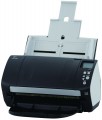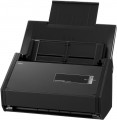Max. resolution
The highest resolution of the digital image generated by the scanner during operation. Specified in dots per inch — dpi (dots per inch).
The higher the scan resolution, the higher the resolution of the resulting image will be (with the same size of the source material) and the more accurately small details will be transmitted on it. On the other hand, high resolution noticeably affects the price of the scanner, increases the processing time and the size of the resulting file — despite the fact that the real need for high detail is not always present, and in some cases it is even unnecessary (for example, when processing an image with small artifacts, not visible at low detail). Therefore, when choosing by this parameter, you should not chase high resolution values — you should proceed from the real need and the specifics of the intended use of the scanner.
The simplest modern scanners have a resolution of about 300x300 dpi — this is quite enough for text recognition with an average font size. And in high-end professional models, this figure can exceed 7000x7000 dpi.
Optical element
— CIS, abbreviation for "Contact Image Sensor" — contact image sensor. The simplest type of optical element: it is a line across the entire width of the scanner's working space, on which photocells that read the image and LEDs that provide illumination are located in a row. They are inexpensive and take up little space, which, accordingly, makes the scanners themselves cheaper and smaller. On the other hand,
CIS sensors have a shallow depth of field, and even small bumps in the scanned image can be out of focus. However, in general, they are quite suitable for both personal and not too complex professional tasks.
— CCD, short for "Charge-Coupled Device" — a charge-coupled device. A much more complex design than CIS, includes a fluorescent lamp, lens and mirror.
CCD scanners are larger, heavier and much more expensive than their counterparts in CIS. On the other hand, this type of optical element provides high-quality colour reproduction and a good depth of field, coping well with complex-shaped media. Therefore, advanced professional scanners are usually equipped with a CCD.
— CMOS. The abbreviation for "Complementary Metal-Oxide-Semiconductor" is a complementary metal-oxide-semiconductor structure (the designation CMOS is also used in Russian). A key feature
of CMOS sensors is that they capture the scanned image as a whole, similar to photography (and not
...line by line, as in other types of optical elements). In fairness, it should be noted that the "instantaneous" scanning does not give a tangible advantage in speed, because. processing the captured image takes quite a long time. However, this feature is extremely useful in cases where it is difficult to ensure the immobility of the scanned material and/or uniform movement of the optical element relative to this material. Such situations often arise when working with book and handheld scanners (see "Type"), so CMOS elements are most popular in such devices.Max. scan area
The maximum image size that the scanner can process at one time, both horizontally and vertically. You should pay attention to this parameter if you need the exact dimensions of the scanner's working area, down to a millimetre: although standard formats are used to designate these dimensions (see "Format"), in fact the dimensions may differ from them.
Colour depth (ext.)
External colour depth characterizes the maximum possible number of colour shades in the image transmitted by the scanner to the computer. A depth of 24 bits is considered quite enough for non-professional tasks, in more advanced models this parameter can reach 96 bits. For details on colour depths and their relationship, see "Colour Depth (Int.)"
Shades of grey
The number of shades of grey that the scanner recognizes. You should pay attention to this parameter if you plan to actively work with complex black-and-white materials (for example, photographs) — the more shades, the higher the quality of the digitized image. To date, the average is considered to be 512 shades — this approximately corresponds to the capabilities of the human eye. Models with a lower indicator belong to the entry level, more advanced ones “understand” 1024 shades.
Mono scanning
The black and white scanning speed provided by the device. Usually, the maximum processing speed for an A4 sheet is indicated, i.e. speed at the lowest resolution. In fact, the speed is usually lower and depends on both the resolution and the size of the original material. The higher the scanning speed, the more convenient it is to work with the scanner; pay special attention to this parameter if you plan to work with numerous black and white images.
Colour scanning
Colour scanning speed provided by the device. In fact, it depends on the selected resolution, colour depth and original dimensions; the characteristics most often indicate the speed for an A4 sheet at the minimum resolution and colour depth, i.e. maximum possible speed. If you only need to scan one or more sheets from time to time, high speed is not too critical, but for working with a large amount of materials, you should look for fast models.
Document autofeed
The maximum number of sheets of standard weight (80 g/m²) paper that can be placed in the scanner's auto feed system at a time. These systems are similar to those installed in printers: a stack of sheets is installed in a special tray, and each of them is fed in turn for scanning. It is worth paying attention to models with this function if you often have to work with numerous documents: you will not need to monitor the process and manually feed sheets — just load the originals into the automatic document feeder and press the button. Many document feeders, some flatbeds, and almost all combination scanners have an ADF (see "Type"). It works, however, only with separate sheets and cannot cope with larger media.
Data transfer
— Wi-Fi. A wireless interface primarily used to build local computer networks. In many respects it is similar to the LAN described below (in particular, it allows using the scanner as a network device), but it compares favorably due to the absence of a cable and the ability to work directly through walls. In addition, relatively recently, Wi-Fi modules have appeared with the ability to directly connect between devices — for example, to control a scanner from a tablet and transfer processed materials to the tablet directly, without creating a computer network. However
scanners with Wi-Fi are quite expensive.
—
USB. Universal interface for connecting various peripherals to a computer, including scanners. Today, it is the most common port of this type; at least one USB input is provided by the vast majority of PCs and laptops.
—
SCSI. Universal interface for connecting computer peripherals; has a good speed, however, it is much less common than its analogues, besides it is considered obsolete and is gradually being replaced by other standards.
—
IEEE-1394. Universal port, in many ways similar to USB (see above). Provides higher speed than the most common USB 2.0, but is much less common.
-LAN. Connector for connecting various devices to a local computer network. A scanne
...r with this interface can be connected as a network device and used with it by any computer on the network, which can be especially useful in offices.
